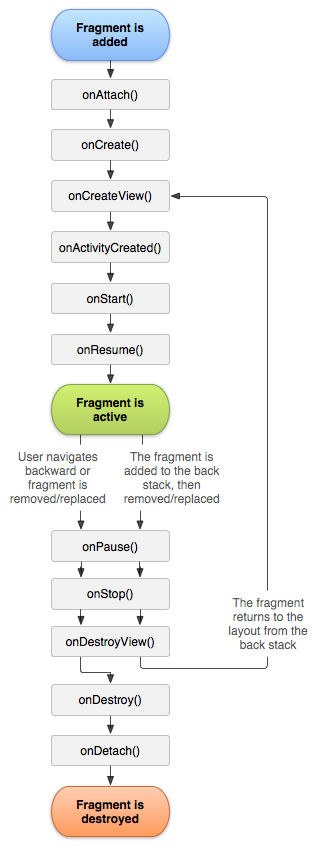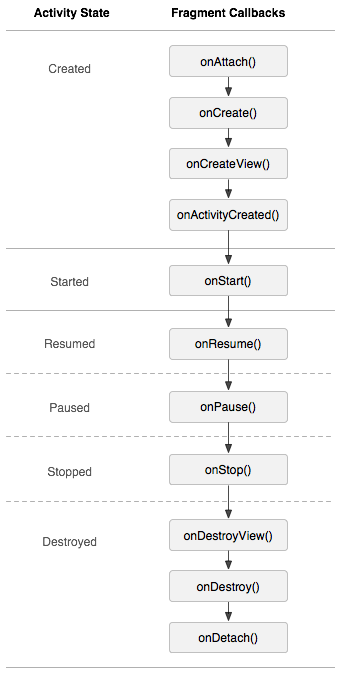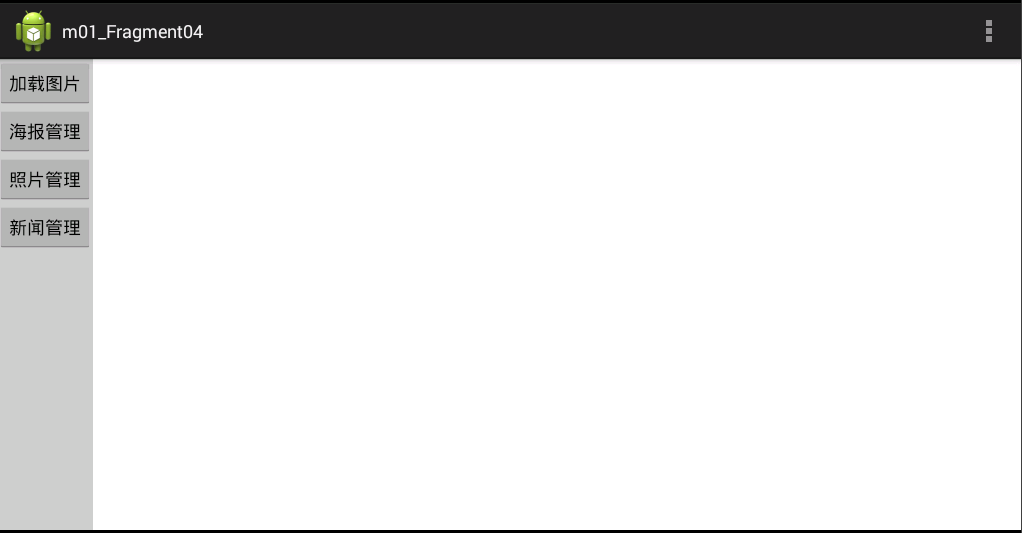Fragment:Activity碎片(必须嵌套在Activity中使用)。
一、Fragment生命周期简介:
因为Fragment必须嵌入在Acitivity中使用,所以Fragment的生命周期和它所在的Activity是密切相关的。
如果Activity是暂停状态,其中所有的Fragment都是暂停状态;如果Activity是stopped状态,这个Activity中所有的Fragment都不能被启动;如果Activity被销毁,那么它其中的所有Fragment都会被销毁。
但是,当Activity在活动状态,可以独立控制Fragment的状态,比如加上或者移除Fragment。
当这样进行fragment transaction(转换)的时候,可以把fragment放入Activity的back stack中,这样用户就可以进行返回操作。
使用Fragment时,需要继承Fragment或者Fragment的子类(DialogFragment, ListFragment, PreferenceFragment, WebViewFragment),所以Fragment的代码看起来和Activity的类似。
每当创建一个Fragment时,首先添加以下三个回调方法:
- onCreate():系统在创建Fragment的时候调用这个方法,这里应该初始化相关的组件,一些即便是被暂停或者被停止时依然需要保留的东西。
- onCreateView():当第一次绘制Fragment的UI时系统调用这个方法,该方法将返回一个View,如果Fragment不提供UI也可以返回null。注意,如果继承自ListFragment,onCreateView()默认的实现会返回一个ListView,所以不用自己实现。
- onPause():当用户离开Fragment时第一个调用这个方法,需要提交一些变化,因为用户很可能不再返回来。
将Fragment加载到Activity当中有两种方式:
方式一:添加Fragment到Activity的布局文件当中
方式二:在Activity的代码中动态添加Fragment(荐)
第一种方式虽然简单但灵活性不够。添加Fragment到Activity的布局文件当中,就等同于将Fragment及其视图与activity的视图绑定在一起,且在activity的生命周期过程中,无法切换fragment视图。
第二种方式比较复杂,但也是唯一一种可以在运行时控制fragment的方式(加载、移除、替换)。
二、Fragment生命周期详解:
先看看官方文档中的图片:
再看看activity和fragment生命周期的对比图:
实例:在MainActivity中添加一个Fragment(完整代码如下)
Fragment布局:fragment01.xml
<?xml version="1.0" encoding="utf-8"?>
<LinearLayout xmlns:android="http://schemas.android.com/apk/res/android"
android:layout_width="match_parent"
android:layout_height="match_parent"
android:orientation="vertical" >
<RatingBar
android:id="@+id/ratingBar1"
android:layout_width="wrap_content"
android:layout_height="wrap_content" />
<Button
android:id="@+id/button1"
android:layout_width="wrap_content"
android:layout_height="wrap_content"
android:text="Button" />
</LinearLayout>Fragment类:MyFragment.java
package com.example.m01_fragmentlifecycle;
import android.app.Activity;
import android.app.Fragment;
import android.os.Bundle;
import android.util.Log;
import android.view.LayoutInflater;
import android.view.View;
import android.view.ViewGroup;
public class MyFragment extends Fragment {
private final String TAG = "MyFragment";
//获得activity的传递的值
@Override
public void onAttach(Activity activity) {
// TODO Auto-generated method stub
super.onAttach(activity);
Log.i(TAG, "--MyFragment->>onAttach");
}
//实例化成员变量
@Override
public void onCreate(Bundle savedInstanceState) {
// TODO Auto-generated method stub
super.onCreate(savedInstanceState);
Log.i(TAG, "--MyFragment->>onCreate");
}
//给当前的fragment绘制UI布局,可以使用线程更新UI
@Override
public View onCreateView(LayoutInflater inflater, ViewGroup container,
Bundle savedInstanceState) {
Log.i(TAG, "--MyFragment->>onCreateView");
View view = inflater.inflate(R.layout.fragment01, null);
// TODO Auto-generated method stub
return view;
}
//表示activity执行oncreate方法完成了的时候会调用此方法
@Override
public void onActivityCreated(Bundle savedInstanceState) {
// TODO Auto-generated method stub
super.onActivityCreated(savedInstanceState);
Log.i(TAG, "--MyFragment->>onActivityCreated");
}
//和activity一致
@Override
public void onStart() {
// TODO Auto-generated method stub
super.onStart();
Log.i(TAG, "--MyFragment->>onStart");
}
//和activity一致
@Override
public void onResume() {
// TODO Auto-generated method stub
super.onResume();
Log.i(TAG, "--MyFragment->>onResume");
}
//和activity一致
@Override
public void onPause() {
// TODO Auto-generated method stub
super.onPause();
Log.i(TAG, "--MyFragment->>onPause");
}
//和activity一致
@Override
public void onStop() {
// TODO Auto-generated method stub
super.onStop();
Log.i(TAG, "--MyFragment->>onStop");
}
//表示fragment销毁相关联的UI布局
@Override
public void onDestroyView() {
// TODO Auto-generated method stub
super.onDestroyView();
Log.i(TAG, "--MyFragment->>onDestroyView");
}
//销毁fragment对象
@Override
public void onDestroy() {
// TODO Auto-generated method stub
super.onDestroy();
Log.i(TAG, "--MyFragment->>onDestroy");
}
//脱离activity
@Override
public void onDetach() {
// TODO Auto-generated method stub
super.onDetach();
Log.i(TAG, "--MyFragment->>onDetach");
}
}Activity布局:activity_main.xml
<LinearLayout xmlns:android="http://schemas.android.com/apk/res/android"
xmlns:tools="http://schemas.android.com/tools"
android:layout_width="match_parent"
android:layout_height="match_parent"
android:orientation="horizontal"
tools:context=".MainActivity" >
<LinearLayout
android:id="@+id/line"
android:layout_width="wrap_content"
android:layout_height="match_parent"
android:orientation="vertical" >
</LinearLayout>
</LinearLayout>Activity类:MainActivity.java
package com.example.m01_fragmentlifecycle;
import android.os.Bundle;
import android.app.Activity;
import android.app.FragmentManager;
import android.app.FragmentTransaction;
import android.util.Log;
import android.view.Menu;
public class MainActivity extends Activity {
private final String TAG = "MainActivity";
private FragmentManager manager;
private FragmentTransaction transaction;
@Override
protected void onCreate(Bundle savedInstanceState) {
super.onCreate(savedInstanceState);
setContentView(R.layout.activity_main);
manager = getFragmentManager();
transaction = manager.beginTransaction();
MyFragment fragment = new MyFragment();
transaction.add(R.id.line, fragment);
transaction.commit();
Log.i(TAG, "--MainActivity->>onCreate");
}
@Override
protected void onStart() {
// TODO Auto-generated method stub
super.onStart();
Log.i(TAG, "--MainActivity->>onStart");
}
@Override
protected void onResume() {
// TODO Auto-generated method stub
super.onResume();
Log.i(TAG, "--MainActivity->>onResume");
}
@Override
protected void onPause() {
// TODO Auto-generated method stub
super.onPause();
Log.i(TAG, "--MainActivity->>onPause");
}
@Override
protected void onStop() {
// TODO Auto-generated method stub
super.onStop();
Log.i(TAG, "--MainActivity->>onStop");
}
@Override
protected void onRestart() {
// TODO Auto-generated method stub
super.onRestart();
Log.i(TAG, "--MainActivity->>onRestart");
}
@Override
protected void onDestroy() {
// TODO Auto-generated method stub
super.onDestroy();
Log.i(TAG, "--MainActivity->>onDestroy");
}
@Override
public boolean onCreateOptionsMenu(Menu menu) {
// Inflate the menu; this adds items to the action bar if it is present.
getMenuInflater().inflate(R.menu.main, menu);
return true;
}
}上面类中的各生命周期阶段的方法里边都打印了日志,运行看日志如下:
初次加载:

点击一下HOME键或者接入电话:
重新进入程序或者接电话完毕:
点击back退出程序:
通过上面的日志,我们能够看出,Fragment和Activity的生命周期太相似了。只是有几个Activity中没有的新方法,需要重点介绍一下:
- onAttach方法:Fragment和Activity建立关联的时候调用(获得activity的传递的值)
- onCreateView方法:为Fragment创建视图(加载布局)时调用(给当前的fragment绘制UI布局,可以使用线程更新UI)
- onActivityCreated方法:当Activity中的onCreate方法执行完后调用(表示activity执行oncreate方法完成了的时候会调用此方法)
- onDestroyView方法:Fragment中的布局被移除时调用(表示fragment销毁相关联的UI布局)
- onDetach方法:Fragment和Activity解除关联的时候调用(脱离activity)
三、Fragment返回栈的管理:
假设现在我们有两个Fragment:Fragment01和Fragment02,我们现在从Fragment01的界面跳到Fragment02,然后按Back键,发现程序是直接退出了,而不是返回到Fragment01。如果现在想实现以下功能:从Fragment01的界面跳到Fragment02,然后按Back键,会返回到Fragment01。这个功能该怎么实现呢?这其实就利用到了返回栈的知识。
其实很简单,FragmentTransaction中提供了一个addToBackStack()方法,可以将一个事务添加到返回栈中。
我们先回顾一下之前动态加载Fragment的代码,然后在此基础之上,增加一行代码就可以将Fragment添加到返回栈中:(即第07行代码)
//步骤一:添加一个FragmentTransaction的实例
FragmentManager fragmentManager =getFragmentManager();
FragmentTransaction transaction = fragmentManager.beginTransaction();
//步骤二:用add()方法加上Fragment的对象
RightFragment rightFragment = new RightFragment();
transaction.add(R.id.right, rightFragment); transaction.addToBackStack(null);
//步骤三:调用commit()方法使得FragmentTransaction实例的改变生效
transaction.commit();第07行代码:我们在事务提交之前调用了FragmentTransaction的addToBackStack()方法,它可以接受一个名字用于描述返回栈的状态,,一般传入null即可。
实例:现在通过代码来实现以下界面(下面的图片为程序运行时加载的首页),并且把每一个Fragment都加入到返回栈当中去,然后观察其生命周期的变化。完整代码如下:
首先新建工程文件m01_Fragment04,然后开始我们的代码之旅:
我们先把右侧的四个Fragment建起来吧:
Fragment01.java主要部分的代码如下:
package com.example.m01_fragment04;
import android.app.Fragment;
import android.os.Bundle;
import android.view.LayoutInflater;
import android.view.View;
import android.view.ViewGroup;
public class Fragment01 extends Fragment {
@Override
public void onCreate(Bundle savedInstanceState) {
super.onCreate(savedInstanceState);
}
@Override
public View onCreateView(LayoutInflater inflater, ViewGroup container,
Bundle savedInstanceState) {
View view = inflater.inflate(R.layout.f1, null);
return view;
}
@Override
public void onPause() {
super.onPause();
}
}为避免啰嗦,这里就不把Fragment01生命周期中的其他函数罗列出来了,我们只要知道在实际代码中这些函数都是加了的。
Fragment01的布局文件f1.xml的代码如下:
<?xml version="1.0" encoding="utf-8"?>
<LinearLayout xmlns:android="http://schemas.android.com/apk/res/android"
android:layout_width="match_parent"
android:layout_height="match_parent"
android:orientation="vertical" >
<TextView
android:id="@+id/textView1"
android:layout_width="wrap_content"
android:layout_height="wrap_content"
android:text="加载图片" />
</LinearLayout>然后依次新建出Fragment02、Fragment03、Fragment04的java代码和布局文件。
MainActivity的布局文件activity_main.xml代码如下:
<LinearLayout xmlns:android="http://schemas.android.com/apk/res/android"
xmlns:tools="http://schemas.android.com/tools"
android:layout_width="match_parent"
android:layout_height="match_parent"
tools:context=".MainActivity" >
<LinearLayout
android:id="@+id/left"
android:layout_width="wrap_content"
android:layout_height="match_parent"
android:background="#CCCCCC"
android:orientation="vertical" >
<Button
android:id="@+id/button1"
android:layout_width="wrap_content"
android:layout_height="wrap_content"
android:text="加载图片" />
<Button
android:id="@+id/button2"
android:layout_width="wrap_content"
android:layout_height="wrap_content"
android:text="海报管理" />
<Button
android:id="@+id/button3"
android:layout_width="wrap_content"
android:layout_height="wrap_content"
android:text="照片管理" />
<Button
android:id="@+id/button4"
android:layout_width="wrap_content"
android:layout_height="wrap_content"
android:text="新闻管理" />
</LinearLayout>
<LinearLayout
android:id="@+id/right"
android:layout_width="0dp"
android:layout_height="match_parent"
android:layout_weight="1"
android:orientation="vertical" >
</LinearLayout>
</LinearLayout>其中,第一个LinearLayout表示左侧的按钮,第二个LinearLayout留给右边的Fragment。
MainActivity.java的代码如下:
package com.example.m01_fragment04;
import android.os.Bundle;
import android.app.Activity;
import android.app.FragmentManager;
import android.app.FragmentTransaction;
import android.view.Menu;
import android.view.View;
import android.view.View.OnClickListener;
import android.widget.Button;
public class MainActivity extends Activity implements OnClickListener{
private FragmentManager manager;
private FragmentTransaction transaction;
private Button button1,button2,button3,button4;
@Override
protected void onCreate(Bundle savedInstanceState) {
super.onCreate(savedInstanceState);
setContentView(R.layout.activity_main);
manager = getFragmentManager();
button1 = (Button)this.findViewById(R.id.button1);
button1.setOnClickListener(this);
button2 = (Button)this.findViewById(R.id.button2);
button2.setOnClickListener(this);
button3 = (Button)this.findViewById(R.id.button3);
button3.setOnClickListener(this);
button4 = (Button)this.findViewById(R.id.button4);
button4.setOnClickListener(this);
}
@Override
public boolean onCreateOptionsMenu(Menu menu) {
// Inflate the menu; this adds items to the action bar if it is present.
getMenuInflater().inflate(R.menu.main, menu);
return true;
}
//通过点击不同的按钮,跳转到不同的Fragment
@Override
public void onClick(View v) {
// TODO Auto-generated method stub
transaction = manager.beginTransaction();
switch (v.getId()) {
case R.id.button1:
Fragment01 fragment01 = new Fragment01();
transaction.replace(R.id.right, fragment01, "fragment01");
transaction.addToBackStack("fragment01");// 添加到Activity管理的回退栈中。
break;
case R.id.button2:
Fragment02 fragment02 = new Fragment02();
transaction.replace(R.id.right, fragment02, "fragment02");
transaction.addToBackStack("fragment02");// 添加到Activity管理的回退栈中。
break;
case R.id.button3:
Fragment03 fragment03 = new Fragment03();
transaction.replace(R.id.right, fragment03, "fragment03");
transaction.addToBackStack("fragment03");// 添加到Activity管理的回退栈中。
break;
case R.id.button4:
Fragment04 fragment04 = new Fragment04();
transaction.replace(R.id.right, fragment04, "fragment04");
transaction.addToBackStack("fragment04");// 添加到Activity管理的回退栈中。
break;
}
transaction.commit();
}
}上当代码中,通过点击不同的按钮,就能跳到对应的Fragment,而这四个Fragment都已经加入到了返回栈当中。运行程序之后,也是这样的。
注意第46行和第72行,transaction = manager.beginTransaction()意味着开始,transaction.commit()意味着结束。
我们就其中的fragment01和fragment02来讨论一下他们的生命周期的变化:
运行程序后,界面如下,没有任何fragment被加载:
点击左侧第一个按钮,加载fragment01:
点击左侧第二个按钮,加载fragment02(此时fragment01被替换,并且被压倒了栈中):

注:如果fragment01在替换的时候没有被压到栈中,那就会被销毁,在执行完onDestroyView()方法后,会继续执行onDestroy()和onDetach()方法。
按back键fragment01回到屏幕(fragment02被销毁):
再按back键,fragment01被销毁:
注:Fragment的返回栈由Activity管理;而Activity的返回栈由系统管理。

































 2364
2364

 被折叠的 条评论
为什么被折叠?
被折叠的 条评论
为什么被折叠?








